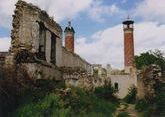At various times, the territory where the city of Iravan was located was part of such states as Urartu, Sasanian Empire, Arab Caliphate, Sajid Empire, Shaddadid, Seljuk Empire, Eldiguzid Empire, Ilkhanate, Timurid Empire, Kara Koyunlu, Aq Qoyunlu, Safavid Empire, Afsharid Empire, Qajar Empire. The socio-economic development of Iravan as a center refers to the periods of Chokhur-e Sa'd and Erivan Khanate. In medieval historical sources, the name of the city was given as Revan and Iravan.
In 1501, after taking the city of Iravan, Shah Ismail ordered his commander Revangul Khan to build a fortress in this territory on the River Zangi. The fortress was built in seven years by Revangul Khan.
As a result of the wars between the Ottoman and Safavid empires, Iravan has changed hands 14 times. And each time, the city was rebuilt after various disruptions. In 1554, the Ottoman troops, having captured Iravan, completely destroyed it. In 1580, the vizier of the Ottoman Empire Lala Mustafa Pasha conquered Irevan again. The Iravan fortress, described by many travelers and historians, was built by Farhad Pasha, during the Ottoman occupation, in 1582-1583 on the site of the former fortress. The Fortress was almost square shaped (790 x 850) and covered an area of 7 hectares.
In 1604, the troops of Shah Abbas I reconquered Iravan from the Turks, but a counter-attack by the Turks forced them to retreat. During the retreat, as a result of the "scorched earth" policy, the entire population of Chokhur-e Sa'd, including the population of Iravan, was resettled to the other side of the Araks River.
In 1635, Ottoman troops again captured Iravan. According to the agreement signed between the Safavids and the Ottomans in 1639, the province of Iravan, including the city of Iravan, passed under the authority of the Safavids. After the fall of the Safavids in 1723, the city was captured by the Turks. In 1733, the ruler of Iran, Nadir Shah, freed Iravan from the Ottomans. In 1747, after Nadir Shah's death, independent khanates arose. Iravan becomes the center of the eponymous khanate.
Unique architectural pearls were built in Iravan: mosques, caravanserais, baths, parks for recreation.
The Khan's palace or Sardar's palace, a unique architectural oriental pear, was built by Hasan Ali Khan Qajar, and in 1760-1770 the palace was rebuilt by Hoseyn Ali Khan (1762-1783) .
The city of Iravan consisted of 4 massives: Gala (fortress), Shahri (Old City), Tepebashi (now called Kond) and Demirbulag (now called Karanki arch).
Russian troops invaded the Iravan Fortress on October 1, 1827.
After the fall of the Iravan Khanate, the Khan palace became the administrative building of the newly formed 'Armenian region'. The desire of the Russian Tsar Nicholas I to see the legendary Iravan fortress, which was the last stronghold of the Khanates of Northern Azerbaijan, was realized in 1837. Nicholas I stayed at the Khan's palace, where he received representatives of the city's various estates.
The well-known Russian writer and diplomat Alexander Griboyedov visited the palace of the Iravan khan in February 1819 as the secretary of Russia's representation in Iran. Sardar Husseingulu khan, considered by Griboyedov the first person after Allah in this region (the Irevan Khanate) and the third person in the Kajar Empire, according to existing traditions, arranged a reception in honor of the guests. Griboyedov could never have imagined that soon after the fall of the Iravan fortress in October 1827, his famous work Woe from Wit will be staged in the same Mirror Hall by Russian officers with his participation.























